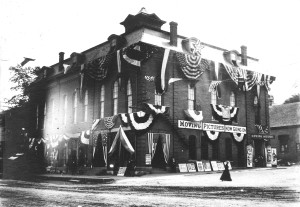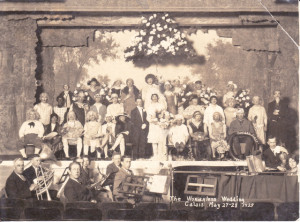Local historian and journalist for the Calais Advertiser H.E. “Ned” Lamb contributed much to our remaining records; in fact, more than any other single source. In this article from around the 1940s, he recounts the story of the St. Croix Opera House. The building still sits at the corner of Church and Main, though it is much changed after a fire in 1935. Most know it today as the J. D. Thomas building. It is presently for sale.
When the ashes of the awful fire of Saturday, August 27, 1870 began to get a little cool, and the people began to count up the losses they owed to boys playing with matches, they found about 30 families homeless, 25 stores burned, 30 other businesses in ruins, 19 schooners burned at the wharfs, besides the wharfs, marine railways, and many intangible things of which no account was made, about in the middle of the ruins were the ashes of the first “St. Croix Hall”. The value was given to the building as $25,000, with $11,000 of insurance.
That fall of 1870 was probably the busiest time Calais ever saw. It was a race to see how much could be built and put under cover before winter. There was no eight hour day. They went to work at six in the morning and worked until six at night, with perhaps an hour off on Saturday afternoon. From the brick yards up along the Brook and over around Union Street there ascended great clouds of incense offered to the gods of business and trade.
The mills were busy getting out studding and boards, and logs were coming down the sluice to rebuild the wharfs.
So this gives you the approximate date of the beginning of the real St. Croix Opera House, that for the next 63 years was to mean so much in the entertainment life of the community and around which has gathered a wealth of pleasant memories for those who were privileged to attend some of the many entertainments| there.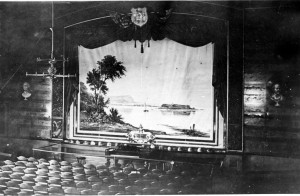
We are glad to present to you this picture of the Old Opera House in its early days. There was not a lot of gaudy paint, but the busts on each side of the proscenium that it was the home of real drama. The curtain was one of the prettiest ever in a theater. It was the largest painting ever made in Calais. A man by the name of Chesley came here to paint it. The center was a picture of Dochet Island with a fanciful border around it.
You will note that the lighting was B. E. (Before Edison and his electric light). It was the open flame gas light, and you might see the janitor come out with a long rod with a slot in the top and a long stringy taper on the side. He would work until he engaged that slot into the key of the gas pipe and then run the taper around the four burners, and the house would become filled with a soft light that would lend a glamour to the entertainment. The footlights were gas also, of course. Bye and Bye Billie Thompson would come out, turn the valve at one end of the footlights, walk along and light the jets back of each tin shield with his taper, and you would sit up and take notice for you knew that the show would soon start. In a few minutes there would come, not the stentor tones of an electric bell, but the soft, pretty notes of a tea bell rung by hand, and your eyes would go down to the bottom of the curtain as it was slowly rolled up revealing the stage, and you settled back into your seat for an evening of pure pleasure.
Plays and Players
A sign could truthfully have been hung over the stage reading, “Many of the best actors of the day have played on this stage.” There was J H. Herne In Hearts of Oak; Dee-man Thompson in the Old Homestead; Richard Golden In Old Jed Prouty; Thomas E. Shea In the Man of Wars Man; Helen Moore in Way Down East. Then there was The County Fair; The Devil’s Auction; East Lynn; Under the Gas Light; House of a Thousand Candles; Oliver Twist and a host of others, all played by the best of actors and actresses.
Opera
Some of the best opera companies sang here like the Boston Opera Company in the Bohemia Girl and many others of as high character. And the singers did not have to hug a crowbar and moan into the top of it. They stood up and sang. If they thought they ought to go over to the right, they went; and they sang and everybody heard them.
Pinafore
Pinafore was sung over and over again, as well as other Gilbert and Sullivan compositions. Sometimes It was out of town companies, sometimes local. Once the Eastport Opera Company came up and sang it.
When ever Pinafore was going to be played, Mr. Calais bought tickets for both himself and his wife, and 60 did his sisters and his cousins and his aunts by the dozens. And everyone hummed “Come buy of your Buttercup, dear little Buttercup, Sweet little Buttercup, I”. Some boys who had a dog with a dark spot over its eye called it Dick Deadeye.
Uncle Tom’s Cabin
“Dry your tears for holy Eva, With the blessed angels leave her; Of the form so soft and fair Give to earth the tender care.” —Whittier
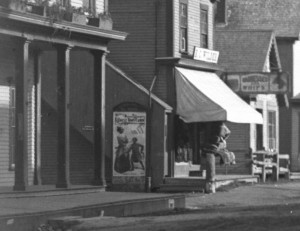
The poster advertising Uncle Tom’s Cabin, located just across the street from the Opera House. It’s hung at the corner of the Emman’s Hotel.
No other play ever had the run that Uncle Tom’s Cabin had, nor as many performances. It was played for years and years, in fact, It was being played almost up to the last War. All sorts of companies played it. It was pirated everywhere. At one time a young person’s education was hardly considered complete, if he or she had not seen Uncle Tom’s Cabin once or more. It was almost a perfect play. It had drama suspense, adventure, pathos, humor, and it stirred feelings to the very depths. The day that Uncle Tom’s Cabin company came to town was a marked one. There was a “big” parade, and everyone wanted to see that, with its band, the boys carrying banners, and others leading the dogs. Not the sleepy, loppy-eared, real bloodhounds eh, dear no. They would not look fierce enough. But big fellows that looked as if they could take Eliza’s baby in just one gulp. There was pretty Eva in her little carriage with Uncle Tom holding the reins. Then there was the band concert just before the evening performance.
John L Sullivan
Yes, the “Great John L. the Boston Strong Boy” and his Company played in the Old St. Croix Opera House. Away back they used to sing, “You’ll ne’re see the day when Sullivan’s colors come down”. But they did. He had Paddy Ryan with him, and they were the show. The rest were nothing but background. James G. Hamilton, who was then running the American House on the Avenue, hitched a pair of horses to a surrey—you know the kind, two seats and a top with fringe around the top—picked up Big Bill McLean | of Milltown and drove the four of them all around town. It was a great day for the “sports”. What a. crowd there was on Church street just to see the two of them enter the hall, their high silk hats looming above the crowd. Of course the highlight of the evening was the boxing match between John L. and Paddy, the rest, being just trimming.
Travel Lectures
Do you remember the two men who gave a series of travel lectures for three evenings, using a dissolving stereopticon, and they used a flue “lime light,” a beautiful white light made by playing a mixture of hydrogen and oxygen on a stick of lime making a wonderful white light for projection. They were wonderful for three evenings. Some theaters use a limelight to spot leading players and adding another phrase to our language, “he loves the limelight”.
Vaudeville
Vaudeville had its run, good, indifferent, bad and worse. Sometimes that street scene curtain was dropped and some singer or dancer filled in between the parts of the play. Singers, dancers, acrobats, jugglers, trick bicycle riders, slight-of-hand performers—excuse me, prestidigitators. Sometimes these ‘came for a whole day and gave away presents to the, children in the afternoon. Then there was the evening performance with trained horses. Wonder if they had trained dogs. They did in the Milltown rink. They run the whole scale. These were real but all you get now is a quick flicker In the movies.
Negro Minstrels
Negro Minstrelsy was a perennial plant, and when the bright posters began to appear everybody sat up and took notice. Of course there was the Big Parade, first the big drum major, and he had to be a big one, with his silver baton swinging high, wide and lively, his big hat loomed up over everything, “What a flourish he would make when the band had to turn a corner. Back of him stretched out the band in their red uniforms, and scattered far apart to make you think .there were more of them than there were. All blowing and pounding as hard as they could, and If their notes seemed to startle a farmer’s team they seemed to blow all tie harder. Some boy in town got the job of carrying the front of the his drum, and others carried the banners. There was the concert on Church street in front of the door and how they did pound. You found out what was meant when people said, drumming up trade. The last piece was played as they went up the stairs, and it a player caught a step going up, he got a sharp, or if he slipped down one he had a flat. But the crowd followed them.
“Gentlemen be Seated,’ has become a part of our language, and you can hear the clash of tambourines, bones, horns, and drums even today. Yes, the idea is carried on today, the love of the old minstrels has never died.
And they had good musicians and singers. There had to be a good low base singer. There was a good quartette. Can’t you hear the high, tenor singing words, and the others imitating the banjo accompaniment. Then one stood up and triple-tongued a solo on a cornet, not one of those blatant trumpets. Oh yes, we had those who could-triple-tongue a cornet, but it required an awful good set of teeth to do It well. Long after they left the small boy was swinging an edging like that baton, and cornets were practiced assiduously.
Graduation
For years it would not seem possible to properly graduate from the Calais Academy unless the diploma was received on the stage of the Opera House. The essays delivered and all the regular ritual attended on graduation seemed to have an added meaning coming from there. Thou, too, sail on, O Ship of State! Sail on, O Union, Strong and Great! We helped to bury that Graduate from the old Union Church some years ago, but you see, that his quotation from Longfellow still lives. Many will recall some specific graduation out of the dear, dead days beyond recall, and you will think of what this one or that one did, and whom this girl or that girl married, perhaps it will be some early eventide when o’re the world the fists of night begins to fall, and Lo, to the heart love sings an old sweet song.
The Amateurs
It would be impossible to count the number of amateur plays, or players, who trod the boards of tie Old Opera House. They ranged from simple plays, perhaps with a lot of children to many ambitious programs as Pinafore. Some .were farces like one of the last when the men, put on the Womanless Wedding.
The Mistletoe Hung In the Castle Hall, and some will recall how Elizabeth Perkins was the beautiful bride at that Christmas Wedding, suddenly ran out of the hall with a challenge to find her. How they hunted high and low, but not a trace was found. Years rolled by, and now George MacNicol, the upstanding bridegroom of years before, now an old man, bent with years, gray of hair and long whiskers, with a candle In his hand was taking one last look. There in an out of the way corner of the attic was an oaken cheat, Getting the lid up, and low there was the bride o£ years before, just a bony skeleton. She had hid in the cheat, the lock snapped, and she could not get out.
We cannot use the May Pole in the climate here, but it could be on the stage in the St. Croix Opera House. The nice looking children, the pretty dresses, the cute dancing as they wove the bright ribbons around fte tall pole, could not be easily forgotten. Then there was the drill by young ladies, armed with brooms as they swept the stage. And so it went, on year after year. All the school children dressed in oriental costumes that could be put on the stage, sang cantatas. Did someone at the last tableau, light Borne red fire in a pan just off the stage and let the red flames rise and fall on the setting? Dangerous? Yes, but we never heard of any one being burned because of a lot of care taken. Away back on Sunday, June 15, 1895, the C. H. S. gave a sacred concert when they charged , fifty cents for a seat on the floor, and. twenty-five for a gallery seat.
The Ten, Twenty, Thirties
Companies of players came to Calais and stayed at least a week. They got their names from the price of the tickets. That gallery would hold a good size crowd at ten cents apiece; the back rows were twenty cents, while the best seats were thirty cents. You might think it would not pay to play at such prices but H. Price Webber or the Mae Edwards and ether companies came year after year and were looked forward to by the people. They would bring a carload of scenery and It would be hauled over on a low bodied truck wagon. What thought the ingénue did have: a grown boy playing a leading male part in the play; the villain got his; the heroine was rescued in the nick of time. Can you hear the big saw as it cut through where the girl was bound? It was a lot of huey but the people liked it and it was no worse than the movies today when the fellow and the girl are floating on the lake in a small boat with no one near. He begins to sing a pretty love song and suddenly a whole orchestra begins to play.
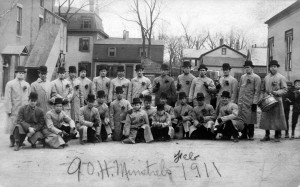
These traveling minstrels came to perform in Calais at the St. Croix Opera House (the back of which is seen on the left) in 1911.
Sometimes these companies carried some vaudeville acts to fill between the parts of the play. or they might have two plays in the one evening, one long and the other short. The hotel had a good week that week and many town folks had a good time.
Pictures
Motion pictures (correct name— the pictures do not move), came along slowly. Men would come to town, hire a hall and give an evening’s entertainment of the new invention. A railway train, waves of the ocean, a bathing scene, and then they would run the film backwards and the bathers would be seen jumping out of the water onto the spring board.
It happened in Milltown. The pictures were advertised for the Methodist vestry. It happened to be the day that President McKinley died. Want the date? September 14, 1901. One of the men got up and said, on account of the death of our beloved President, we do not think it proper to put on any Humorous pictures tonight. Then they proceeded to put on one of the best skirt dances we ever saw in a Methodist vestry. The Minister’s wife and another woman went out.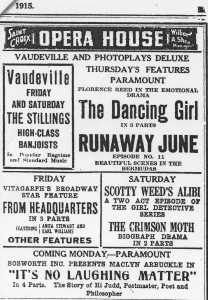
It was inevitable that the pictures should come to the theaters. They were new, they were interesting and they filled in gaps in the program. So they came to the Old Opera House. You want the date? Well, here it is, September 13, 1903, Many wanted to see the new invention. How some would duck to avoid getting the high wave in the face. Of course they got used to them, and there was talk of how the pictures were actually still for a moment on the curtain, and how many were on the curtain every second, and how it was the persistence of vision, that caused the pictures to appear to move.
We do not know if the first long picture, Edison’s, The Great Train Robbery, was shown in The Old Opera House, and which was so real that one reviewer wrote that you could even see the smoke of men’s guns. But the other great ones were. The Four Horsemen, The Ten Commandments, Way Down East, and the greatest of them all, The Birth of a Nation. They haven’t quite equaled it yet. Of course the pictures were silent. Edison experimented with a talking picture, using his phonograph on the stage and controlled from the booth. But it was not a great success, ‘although it was used up and down the coast of South Am erica. The picture may have been silent but the machine was not. So they used music to drown the noise and give atmosphere to the picture.’ In the smaller places there was a piano and a drummer. In larger places where there was more money there might be an orchestra or even a fine pipe organ. When Way Down East first came around they brought their own orchestra and a carload of effects, but the seats ran up to two dollars besides the tax.
Here in Calais Frank Lane played the piano, and at one time a man by the name of Billie Gilbert attended to the drums. A good pianist knew about what music should be played just when, and a good drummer could produce almost any affect. If it was a battle scene it took almost all its instruments to make the audience think a real battle was going on. He had to watch the screen so as to “know just when the hero’s six shooter “went off to save the heroine. The two who played the longest were Mrs. Ina Creamer at the piano and the late Frank Billings at the drums. Frank got some of his education in music on a Show Boat and he had a good one. There came with the picture sheets with suggestions for the music and when to play it.
Besides the picture there were Illustrated Songs. Colored stereoscopic slides on the screen while a singer sang the words. There were a number of singers in The Old Opera House through the years. There were Miss Ada Barclay, Mrs. Frank McKay, Mrs. Frank Fenderson, Beulah Dennison, William Brandt, Mr. Ryan of Woodstock, Dolor Villeaux of Bangor. (Note— if you know of some others do not stop us on the street and say Miss So-and-So sang in the Opera House. Write the names on paper and give them to us, or better still, send by mail).
After a while a very fine mechanical organ was put in at the right on level with the gallery. But there was trouble. When He took Her in his arms, (it was the thirteenth time they had practiced it) and impressed a fond kiss on her rosy (black on the screen) lips, the organ might be playing Ta-ra-ra-Boom-de-ay or the Dead March from Saul. And when the funeral procession of a President marched along the screen it was playing jazz. It was too much, as Josh Billings would say.
The years passed by and the end was near. It was on May 2, 1935, that the audience looked up at the fine oil painting of that wonder horse Lineus, that hung on the back stairs that went to the gallery, and in the well of the main stairs. That horse whose tail was 14 feet long and whose mane lay on the ground. And when they passed down those stairs for the last time, for at midnight the bells were ringing for all fire companies, and that was the last of that beautiful Dochet curtain, that organ, the picture machine, the back drops, all went toward heaven in smoke and flames or dropped to the ground in ashes. The Old Opera House did not live the three score and ten years that the Bible mentions, but for more than three score years it had served its day and generations well, and there, has been no other, for a very wide region that has had so many pleasant memories connected with it as THE OLD ST. OPERA HOUSE.

